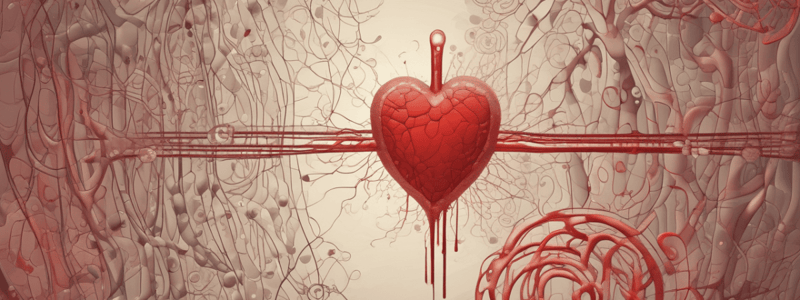Podcast
Questions and Answers
What is the primary cause of hemophilia?
What is the primary cause of hemophilia?
- Bacterial infection
- Trauma
- Viral infection
- Genetic mutation in genes (F8,F9 & F11) (correct)
What is the primary symptom of hemophilia?
What is the primary symptom of hemophilia?
- Excessive bleeding
- Easy bruising
- Joint pain
- All of the above (correct)
What is the purpose of a CBC test in diagnosing hemophilia?
What is the purpose of a CBC test in diagnosing hemophilia?
- To measure blood pressure
- To check for low blood count (correct)
- To diagnose sickle cell disease
- To test for clotting factor deficiency
What is the recommended treatment for hemophilia?
What is the recommended treatment for hemophilia?
What is the name of the disorder caused by a deficiency of factor IX?
What is the name of the disorder caused by a deficiency of factor IX?
What is the primary purpose of a PT test in diagnosing hemophilia?
What is the primary purpose of a PT test in diagnosing hemophilia?
What is the recommended intervention for a patient with hemophilia experiencing hemarthrosis?
What is the recommended intervention for a patient with hemophilia experiencing hemarthrosis?
What is the primary benefit of cooperation with a hematologist in dental management?
What is the primary benefit of cooperation with a hematologist in dental management?
What is the primary symptom of hemophilia that affects the mouth?
What is the primary symptom of hemophilia that affects the mouth?
What is the primary reason for diagnosing hemophilia?
What is the primary reason for diagnosing hemophilia?
Study Notes
Hemophilia
- Hemophilia is a rare, genetic blood disorder that occurs when the blood doesn't clot properly, leading to prolonged bleeding.
Types of Hemophilia
- There are three main types of hemophilia: Hemophilia A, Hemophilia B, and Hemophilia C.
- Hemophilia A is the most common type, caused by a deficiency of clotting factor VIII.
- Hemophilia B, also known as Christmas disease, is a rare type caused by a deficiency of clotting factor IX.
- Hemophilia C is caused by a deficiency of clotting factor XI.
Inheritance Patterns
- Hemophilia A and B are X-linked recessive diseases, meaning the genes are present on the X chromosome.
- Males are more affected than females because they only need one copy of the mutated gene to show symptoms.
- Hemophilia C is an autosomal recessive disease, meaning the gene is present on chromosome 4, and both males and females are equally affected.
Symptoms
- Symptoms of hemophilia include prolonged bleeding, sudden bloody noses, bleeding of the mouth and gums, oozing after tooth extractions, bleeding in the urine or stool, easy bruising, joint bleeding (hemarthrosis), and bleeding into the brain.
- Severity of symptoms depends on the severity of the mutation.
Severity of Hemophilia
- Hemophilia can be categorized as mild, moderate, or severe based on the amount of clotting factors in the blood.
- Severe hemophilia: less than 1% of normal clotting factors.
- Moderate hemophilia: 1% to 5% of normal clotting factors.
- Mild hemophilia: 5% to 30% of normal clotting factors.
Diagnosis
- Diagnostic tests include complete history and physical examination, medical history, and laboratory tests such as CBC, PT, and specific clotting factor tests.
- 0-5% of the population in certain regions are affected by the disease.
Treatment
- Currently, there is no cure for hemophilia, but medical treatment is available.
- Main treatment is Protein Replacement Therapy, which involves injecting clotting factor concentrates into a vein to replace the missing or low clotting factor.
- Life enhancement strategies include developing an exercise routine, maintaining a healthy weight, and having good dental hygiene.
Oral Manifestations
- Patients with hemophilia may experience excessive gingival bleeding, high rate of infections in the oral cavity, and joint pain and limited mouth opening due to TMJ bleeds.
- Hemophiliac children tend to have better dental health.
Dental Management
- Dental management involves obtaining the patient's medical history, communicating with hematologists, avoiding certain pain medications, and using intensive treatments in hospitals or community dental services.
- Maintaining good oral health is a priority for hemophiliacs, and can be achieved through regular dental visits, brushing twice daily, using interdental cleaning aids, and limiting sugary food and drinks.
Studying That Suits You
Use AI to generate personalized quizzes and flashcards to suit your learning preferences.
Related Documents
Description
Hemophilia is a rare genetic disorder that affects blood clotting, leading to uncontrolled bleeding. It occurs when the body lacks sufficient clotting factors. Learn about the causes and effects of this condition.




